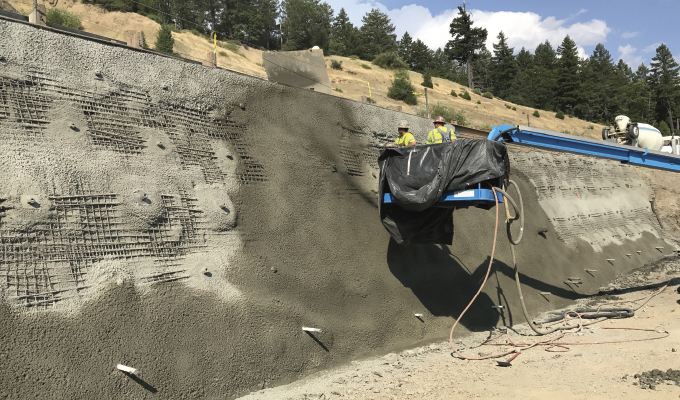Shotcrete has revolutionized slope stabilization, offering a quick, reliable fix for mitigating landslides and effectively reinforcing unstable ground. Its versatility makes it ideal for a range of stabilization scenarios, as it can be applied to both natural and engineered slopes and seamlessly integrates with techniques like soil nails and rock anchors. Unlike traditional casting methods that require cumbersome formwork, shotcrete is applied rapidly to even the most irregular surfaces. The process involves projecting a mix of cement, aggregate, and water onto a slope at high velocity, creating a dense, durable layer with performance characteristics generally equivalent to cast-in-place concrete.
This solution has become vital for maintaining the integrity of roadways and other critical infrastructure, especially in areas with steep slopes and in high-traffic and high-risk locations prone to heavy rainfall or freeze-thaw cycles that can cause erosion. Its effectiveness, however, hinges on understanding the optimal conditions for use and safe and effective application.
SITE REVIEW AND SURFACE PREP
As is the case when entering any jobsite, proper preparation is crucial for success when using shotcrete as a stabilization solution. First, crew leaders should conduct a site safety assessment. This will not only help identify potential hazards but will also determine the appropriate equipment to use. For example, if needing to reach hard-to-access locations, a shotcrete robot may be a better option than traditional shotcrete equipment. The shotcrete robot enables technicians to spray shotcrete remotely, with the assistance of hydraulically powered equipment, rather than by manually holding a shotcrete hose—increasing potential production rates, providing higher-quality installations, and allowing the operator to control the equipment remotely from a safe distance.
If the shotcrete must be pumped far distances, horizontally or vertically, it may require the installer to collaborate with the design engineer to make shotcrete mix adjustments that will facilitate a safe and quality installation. It is possible to successfully pump shotcrete hundreds of feet away from the pump with adequate planning and collaboration between contractors and engineers. Improper planning will result in plugs, quality issues, and potential delays to the project.
Once safety assessments have been made and equipment considered, the surface will need to be prepped to ensure a strong adhesion is achieved. The substrate should be cleaned and free of loose debris, oils, and contaminants. Seasonally, cold weather concreting best practices should be followed to ensure that the ground surface is protected from freezing prior to the application of shotcrete. The team can then set up the required reinforcement along the site, such as steel mesh, rebar, drain strips, and other drainpipes and outlets that will be integrated into the shotcrete facing.
EQUIPMENT CHECKS AND CALIBRATION
Employees must be up to date with industry certifications and training before stepping onto the jobsite, just as equipment should be rigorously inspected prior to each use. Conduct daily checks to ensure all equipment is accounted for, is set up appropriately, and performs as it should. This includes the tools necessary for site prep, reinforcement, shotcrete application, and personal protection gear. Be diligent in looking for any new wear and tear that could impair the equipment’s efficacy and safety.
All shotcrete equipment must also be properly calibrated prior to application. To ensure consistent material delivery, air pressure and feed rates should be adjusted based on the mix and jobsite conditions. Proper nozzle operation is especially crucial in achieving uniform application and waste reduction. High-quality nozzlemen can significantly reduce material waste, which emphasizes the importance of properly trained and qualified personnel in controlling the costs and quality of any shotcrete application. Routine maintenance and checks of all shotcrete equipment will also prevent unexpected breakdowns and issues that can introduce hazards, such as blockages during application.
EFFECTIVE APPLICATION
When applied correctly, shotcrete offers similar strength, density, and durability to cast-in-place concrete while offering a more versatile and economical solution. Shotcrete is applied in layers to gradually build the desired thickness, forming a strong and durable coating. When applied correctly in layers, research by the American Shotcrete Association and American Concrete Institute (ACI) has also proven that no cold joint is formed. During application, avoiding excessive buildup in a single pass is imperative, as it can lead to poor bonding and uneven curing. Maintaining a consistent spraying angle and distance will help ensure uniform application and minimize rebound.
The proper application also calls for a shotcrete mix tailored to the specific project requirement. Proper mix design can improve workability, strength and durability, permeability, chloride penetration, and other variables, and should be appropriate for the application, the placement methods, and the environmental conditions—such as temperature fluctuations. Ensuring that the mix and placement method are tailored to the environmental conditions can improve shotcrete quality significantly as compared to placing and curing during adverse conditions.
Depending on the aesthetic desired, sculpted shotcrete can also imitate natural rock or create decorative texture. This method requires shaping the shotcrete shortly after it is applied while it is still wet and malleable.
LONG-TERM STABILITY
Shotcrete’s advantages make it a preferred choice for top-down slope stability projects, as well as ensuring safety and increasing the service life of infrastructure. The ability to rapidly apply shotcrete without formwork and its strong adhesion to slopes have become particularly advantageous in emergency situations needing swift stabilization, and where prolonged road closures can cause logistical challenges. By prioritizing thorough site analysis and surface preparation, maintaining proper mix proportions, and employing skilled application techniques and equipment, engineers will continue to demonstrate the effectiveness of shotcrete, while providing a value-add solution for clients and peace of mind for travelers.
About the Author
Matthew Reihl is the director of business development at GeoStabilization International, where he leads a team of highly qualified engineers and geologists and oversees the development of optimized, value-add solutions that mitigate the dangers of geohazards and enhance public safety. Reihl works closely with local, state, and federal agencies to advocate for proactive geohazard mitigation planning and management practices.


